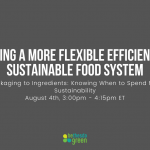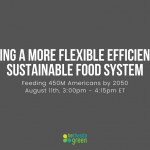Bethesda Green’s Summer 2020 Speaker Series: Tackling Environmental Challenges Through Sustainable Entrepreneurship aims to educate and inspire prospective entrepreneurs by highlighting gaps in the market, and challenging them to address those gaps with innovative and sustainable for-profit business solutions. During this series, 18 speakers, including founders, industry experts, and policy makers, are coming together to discuss two primary topics: 1) Building a More Flexible, Efficient, and Sustainable Food System and 2) Establishing a Circular Economy.
The following is a summary of the third session.
Session #3: How Fashion can Embrace Sustainability and the Circular Economy
Watch the full session on YouTube here: https://youtu.be/t42me00UCkM
Speakers included Amy Hall, Vice President of Social Consciousness for Eileen Fisher, Vanessa Barboni Hallik, Founder of Another Tomorrow, Danielle Nkojo, Manager of Global Sustainability Brands at Kontoor Brands, Julia Daviy, Founder of Julia Daviy, and Kaveri Marathe, Sustainability Consultant at the World Bank Group, who moderated this discussion.

Industrialization ushered in a new era of fashion production. Fabric and garments could be manufactured with higher quality and in shorter periods of time than ever before. However, this improved production capacity paired with unmatched levels of environmental degradation. As climate change persists, our society is in critical need of an eco-friendly fashion industry. In this session, panelists covered issues with consumerism, the fashion supply chain, and opportunities to advance sustainability. Below are the key takeaways.
Corporate Social Responsibility in the fashion industry? System change is needed.
Inherently, the fashion industry involves consumption. On average, an American consumer purchases one mid-priced item of clothing per week. As brands seek to balance sustainable initiatives with their business models, companies are challenged to identify innovative solutions and look within their processes to find areas where they can improve.
Moderator Kaverei Marathe challenged panelists to imagine what the fashion industry might look like if it was not based on consumption. Vanessa Barboni Hallik said that, “it will require a real re-think about adding genuine value and how big [companies] need to be.” Perhaps we’ll need to rethink the idea of growth for the sake of growth. After all, she said, “[the pandemic has] really taught us how much we actually need, which is not a lot actually.” She’s confident that a new philosophy based on having fewer, better things will prevail.
Panelists agreed that in order to unlock this sort of systemic change in the fashion industry, companies need to become more transparent about their labor and sourcing practices. Sustainable scorecards on clothing tags would give consumers visibility into the environmental impacts of each product in a store. For Danielle Nkojo, educated consumers, knowledgeable about water and carbon impacts of their fashion purchases, may increasingly help steer the industry into providing more eco-friendly options. Barboni Hallik added, “sunlight is the best disinfectant.”
The Challenges of a Diverse and Geographically Disparate Supply Chain
A big challenge for designers is that their sustainable aspirations aren’t always possible when working with the vast majority of fabric suppliers. Panelists felt that even though the conversation surrounding sustainable fashion has made great strides in understanding the urgency of finding eco-friendly solutions, there’s still a big disconnect between their vision and reality. They shared their experiences sourcing fabrics and learning how many suppliers were not able to meet their quality and sustainability standards.
Amy Hall believes that changing human behavior is the key. She thinks that designers, consumers, and producers need to give suppliers a reason to change their business and become more sustainable, even after being so successful for all these years. Barboni Hallik agreed with this, and discussed how she struggled to find wool suppliers that met her animal welfare and environmental needs. Eventually, she developed a personal relationship with two farms and sourced the materials herself. Though it’s certainly more difficult to establish a more socially conscious supply chain, panelists know that having these conversations with suppliers will motivate real change. In the future, Nkojo believes that improving traceability through innovative methods like blockchain allows the consumer to track the sustainability of their product all the way back to the seed. Ultimately she is confident that this kind of transparency will cause some big transformations in supplier behavior.
Technological Innovations and Business Opportunities for the Industry
Panelists repeatedly emphasized that there are a lot of changes that need to take place in the fashion industry, and there are many opportunities for entrepreneurs to tackle. Beyond fixing the issues with the fashion industry’s supply chain, there are a number of technological innovations and business opportunities that can further reduce the environmental footprint of the industry.
For instance, Julia Daviy knew she wanted to create a fashion line, but struggled to create products that were truly sustainable until she began working with 3D printers. She utilizes a technique called additive manufacturing, which produces 3D objects one layer at a time. In the past decade, 3D printing has become so advanced that it should be no surprise that clothes can be printed, yet many consumers are unaware that this technology exists.
3D printing caught Daviy’s eye because the design can be created entirely on her computer, garments can be manufactured in the same building as the computer used to design it, and the materials have the potential to be recycled over and over without losing any quality. 3D printing generates significantly smaller amounts of material waste, and allows designers to turn a 3D printed handbag into a 3D printed skirt.
Other panelists agreed that there is a need for more sustainable fabrics. Daviy mentioned that at the intersection of material science, sustainability, and technology there’s so many opportunities to develop garments and accessories out of new materials like cactus leather, orange peel leather, and mushroom leather. Many noted that hemp has a lot of desirable qualities for eco-friendly clothing, but the intermediary processes that transform hemp from fiber to fabric are missing in the United States. As a result, hemp must be sent overseas for processing, so panelists encouraged entrepreneurs to tackle that challenge.
Yet the existence of sustainable fabrics on their own may not be enough on its own. Hall mentioned that there is a strong demand for companies that can collect, sort, and disassemble used clothing and make it easier for fashion brands to recycle fabrics, but a solution is still not widely available.
Summaries and videos to the 2020 Bethesda Green Summer 2020 Speaker Series: Tackling Environmental Challenges Through Sustainable Entrepreneurship can be found here.
About the Author:
Sam Wenger is a Summer Intern at Bethesda Green’s Innovation Lab. He is pursuing a Master of Science in Energy and Sustainability from Northwestern University, and recently graduated from Cornell University with a Bachelor of Science in Operations Research & Information Engineering.





